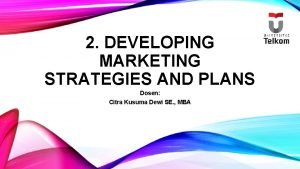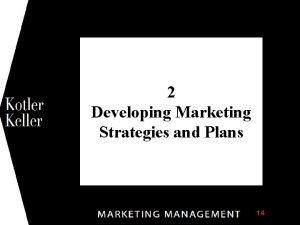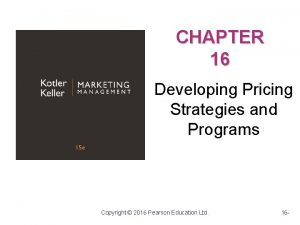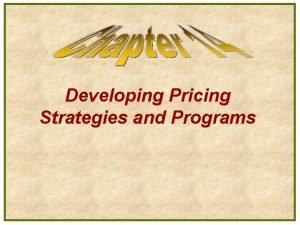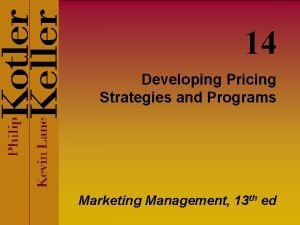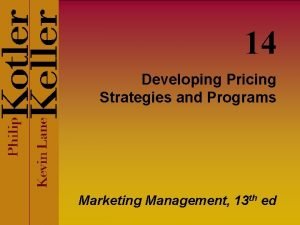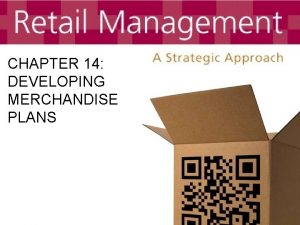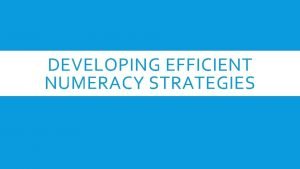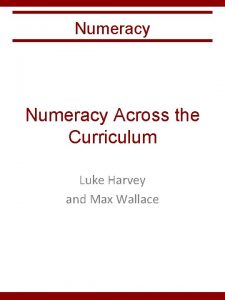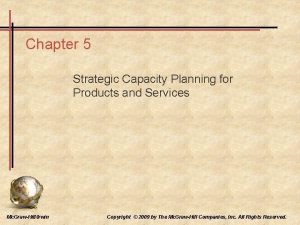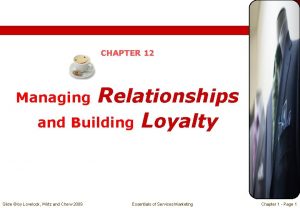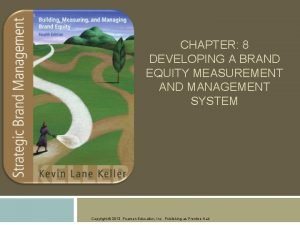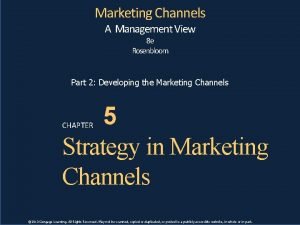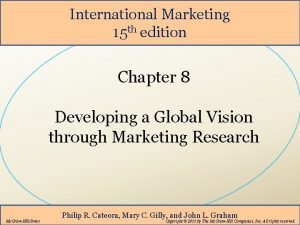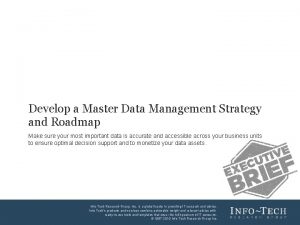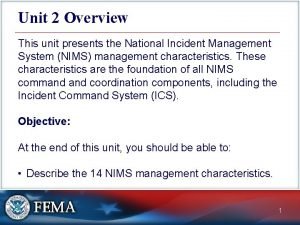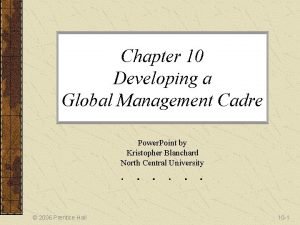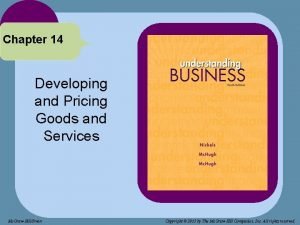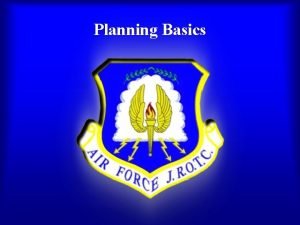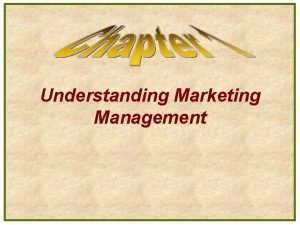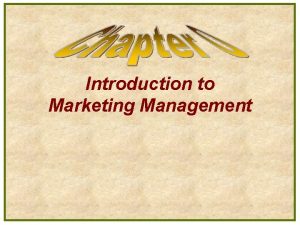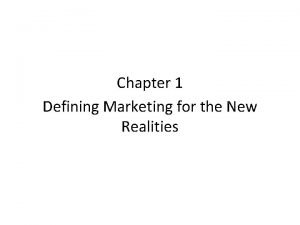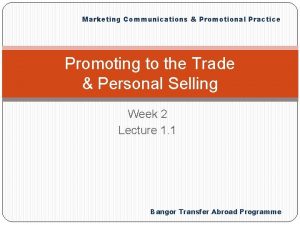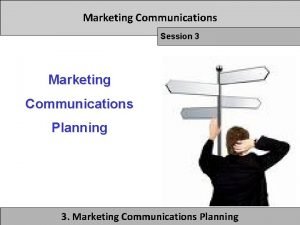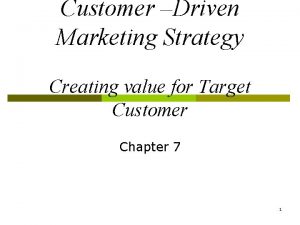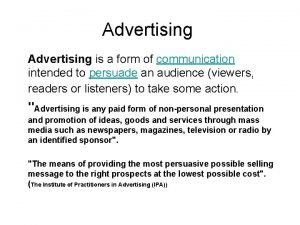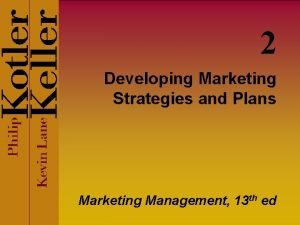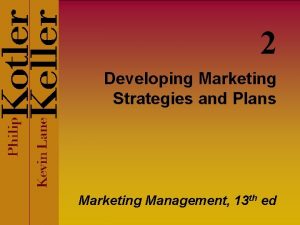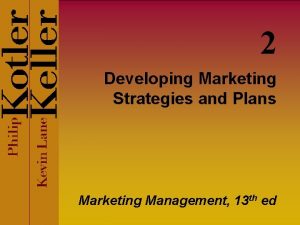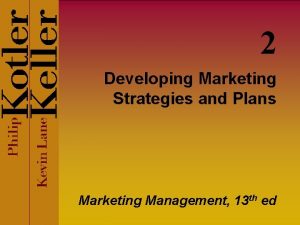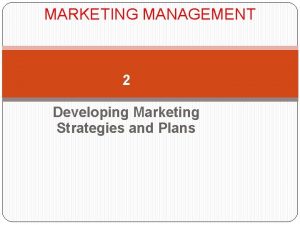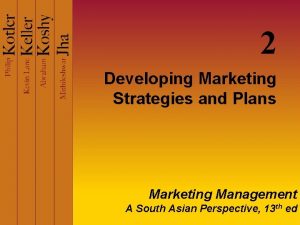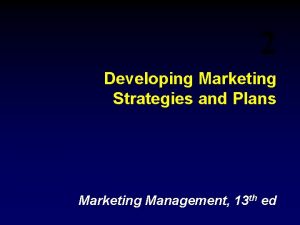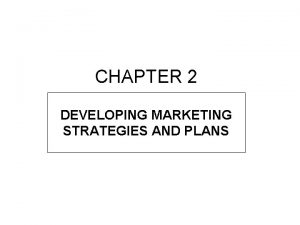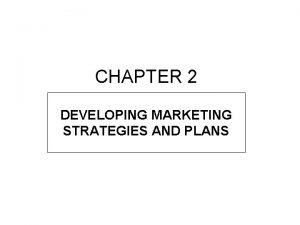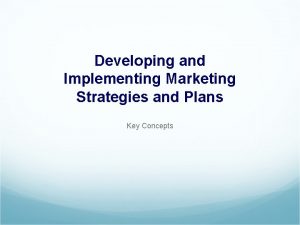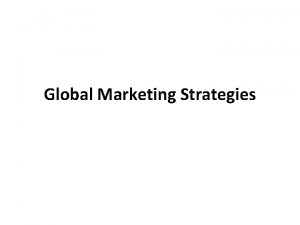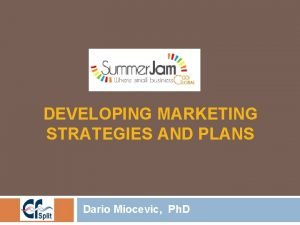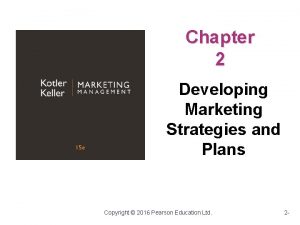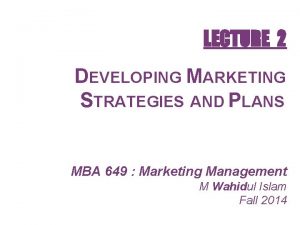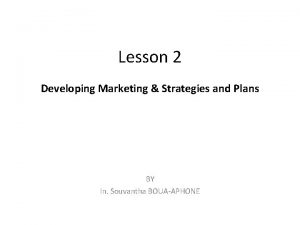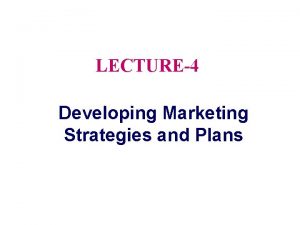2 Developing Marketing Strategies and Plans Marketing Management











































- Slides: 43

2 Developing Marketing Strategies and Plans Marketing Management, 13 th ed

Chapter Questions • How does marketing affect customer value? • How is strategic planning carried out at different levels of the organization? • What does a marketing plan include? Copyright © 2009 Pearson Education, Inc. Publishing as Prentice Hall 2 -2

Marketing & Customer Value • Marketing involves satisfying consumers’ needs and wants. • The task of any business is to deliver customer value at a profit. Copyright © 2009 Pearson Education, Inc. Publishing as Prentice Hall 2 -3

The Value Delivery Process • The traditional view of marketing is that the firm makes something and then sells it. • Will not work in economies where people face abundant choice. • New belief: marketing begins with the planning process. Copyright © 2009 Pearson Education, Inc. Publishing as Prentice Hall 2 -4

The Value Delivery Process Value creation and delivery consists of three parts: • Choosing the value (segment the market, define target market, develop “offering”). • Providing the value (product features, prices, and distribution channels). • Communicating the value (sales force, advertising, and promotional tools). Copyright © 2009 Pearson Education, Inc. Publishing as Prentice Hall 2 -5

Three V’s Approach to Marketing Nirmalya Kumar’s 3 “Vs” approach to marketing: • Define the value segment (customer needs) • Define the value proposition • Define the value network Frederick Webster views marketing in terms of: • Value defining process: Market research &company self analysis • Value developing processes: Product development • Value delivering processes: Advertising& Distribution Copyright © 2009 Pearson Education, Inc. Publishing as Prentice Hall 2 -6

What is the Value Chain? The value chain is a tool for identifying was to create more customer value because every firm is a synthesis(consists) of primary and support activities performed to design, produce, market, deliver, and support its product. (Cisco) Copyright © 2009 Pearson Education, Inc. Publishing as Prentice Hall 2 -7

Corporate Value Chain Prentice Hall, 2002 Chapter 4 Wheelen/Hunger 8

Core Business Processes • Market-sensing process ( Gathering Market Information) • New-offering realization process all activities in researching , developing, and lunching high quality products • Customer acquisition process ( Defining and choosing customers) • Customer relationship management process • Fulfillment management process all activities in receiving , orders shipping and collecting money Copyright © 2009 Pearson Education, Inc. Publishing as Prentice Hall 2 -9

Characteristics of Core Competencies • A source of competitive advantage (internal ) • Applications in a wide variety of markets (skills) • Difficult to imitate To copy • E. g: Nike: Shoe design & Merchandising Copyright © 2009 Pearson Education, Inc. Publishing as Prentice Hall 2 -10

Table 2. 1 Becoming a Vigilant (cautious)Organization • Can we learn from the past? • How should the present be evaluated? • What do we envision for the future? Copyright © 2009 Pearson Education, Inc. Publishing as Prentice Hall 2 -11

What is Holistic Marketing? Holistic marketing sees itself as integrating the value exploration, value creation, and value delivery activities with the purpose of building long-term, mutually satisfying relationships and co -prosperity among key stakeholders. Copyright © 2009 Pearson Education, Inc. Publishing as Prentice Hall 2 -12

Figure 2. 1 A Holistic Marketing Framework Copyright © 2009 Pearson Education, Inc. Publishing as Prentice Hall 2 -13

Value Exploration • Customer’s cognitive space (reflects existing and latent needs and includes participation, stability, freedom, and change). • Company’s competence space (broad versus focused scope of business) • The collaborator resource space (horizontal and vertical partnerships). Copyright © 2009 Pearson Education, Inc. Publishing as Prentice Hall 2 -14

Value Creation • Marketer’s need to: • Identify new customer benefits from the customer’s view. • Utilize core competencies. • Select and manage business partners from its collaborative networks. Copyright © 2009 Pearson Education, Inc. Publishing as Prentice Hall 2 -15

Value Delivery—What Companies Must Become? • Proficient at customer relationship management. • Who the customers are, and respond to different customer opportunities. • Internal resource management. • Integrate major business processes within a single family. • Business partnership management. • Allow the company to handle complex relationships with its trading partners. Copyright © 2009 Pearson Education, Inc. Publishing as Prentice Hall 2 -16

What is a Marketing Plan? A marketing plan is the central instrument for directing and coordinating the marketing effort. It operates at a strategic and tactical level. Copyright © 2009 Pearson Education, Inc. Publishing as Prentice Hall 2 -17

Levels of a Marketing Plan • Strategic • Target marketing decisions • Value proposition • Analysis of marketing opportunities • Tactical • • • Product features Promotion Merchandising Pricing Sales channels Service Copyright © 2009 Pearson Education, Inc. Publishing as Prentice Hall 2 -18

Corporate Headquarters’ Planning Activities • Define the corporate mission • Establish strategic business units (SBUs) • Assign resources to each SBU • Assess growth opportunities Copyright © 2009 Pearson Education, Inc. Publishing as Prentice Hall 2 -19

Strategic Vision vs. Mission • A strategic vision concerns a firm’s future business path - “where we are going” • Markets to be pursued • Future product/market/ customer/technology focus • Kind of company management is trying to create • The mission statement of a firm focuses on its present business purpose - “who we are and what we do” • Current product and service offerings • Customer needs being served • Technological and business capabilities

Characteristics of a Mission Statement • Identifies the boundaries of the current business and highlights • Present products and services • Types of customers served • Geographic coverage • Conveys • Who we are, • What we do, and • Why we are here A well-conceived mission statement distinguishes a company’s business makeup from that of other profit-seeking enterprises in language specific enough to give the company its own identify!

Trader Joe’s Mission Statement (a unique grocery store chain) To give our customers the best food and beverage values that they can find anywhere and to provide them with the information required for informed buying decisions. We provide these with a dedication to the highest quality of customer satisfaction delivered with a sense of warmth, friendliness, fun, individual pride, and company spirit.

Motorola “ The purpose of Motorola is to honorably serve the needs of the community by providing products and services of superior quality at a fair price to our customers; to do this so as to earn an adequate profit which is required for the total enterprise to grow; and by doing so, provide the opportunity for our employees and shareholders to achieve their personal o b j e c t i v e s. ” Copyright © 2009 Pearson Education, Inc. Publishing as Prentice Hall 2 -23

Good Mission Statements • • • Focus on a limited number of goals Stress major policies and values Define major competitive spheres Take a long-term view Short, memorable, meaningful Copyright © 2009 Pearson Education, Inc. Publishing as Prentice Hall 2 -24

Major Competitive Spheres company will operate • Industry : one or more • Products: define the range of products they will supply • Competence: identify the level of technology it will master and leverage • Market segment: the type of customers • Vertical channels: the number of channel levels , from raw material to final product and distribution • Geographic: range of regions, countries in which company operate Copyright © 2009 Pearson Education, Inc. Publishing as Prentice Hall 2 -25

Table 2. 3 Product Orientation vs. Market Orientation Company Product Market/Needs Missouri-Pacific Railroad We run a railroad Xerox We make copying We improve office equipment productivity Standard Oil We sell gasoline We supply energy Columbia Pictures We make movies We entertain people Copyright © 2009 Pearson Education, Inc. Publishing as Prentice Hall We are a peopleand-goods mover 2 -26

Dimensions that Define a Business • Customer groups : Different customers • Customer needs • Technology e. g. Incandescent Lightening system for television studios Copyright © 2009 Pearson Education, Inc. Publishing as Prentice Hall 2 -27

Characteristics of SBUs • It is a single business or collection of related businesses • It has its own set of competitors • It has a leader responsible for strategic planning and profitability Copyright © 2009 Pearson Education, Inc. Publishing as Prentice Hall 2 -28

Figure 2. 3 The Strategic Planning Gap Copyright © 2009 Pearson Education, Inc. Publishing as Prentice Hall 2 -29

Ansoff’s Product-Market Expansion Grid/ starbucks • • Market penetration strategy Market development strategy Product development strategy Diversification strategy Copyright © 2009 Pearson Education, Inc. Publishing as Prentice Hall 2 -30

Figure 2. 4 Ansoff’s Product-Market Expansion Grid Copyright © 2009 Pearson Education, Inc. Publishing as Prentice Hall 2 -31

What is Corporate Culture? Corporate culture is the shared experiences, stories, beliefs, and norms that characterize an organization. Copyright © 2009 Pearson Education, Inc. Publishing as Prentice Hall 2 -32

Figure 2. 5 The Business Unit Strategic Planning Process Copyright © 2009 Pearson Education, Inc. Publishing as Prentice Hall 2 -33

SWOT Analysis • • Strengths Weaknesses Opportunities Threats Copyright © 2009 Pearson Education, Inc. Publishing as Prentice Hall 2 -34

Market Opportunity Analysis (MOA) • Can the benefits involved in the opportunity be articulated convincingly to a defined target market? • Can the target market be located and reached with cost-effective media and trade channels? • Does the company possess or have access to the critical capabilities and resources needed to deliver the customer benefits? Copyright © 2009 Pearson Education, Inc. Publishing as Prentice Hall 2 -35

Market Opportunity Analysis (MOA) (cont. ) • Can the company deliver the benefits better than any actual or potential competitors? • Will the financial rate of return meet or exceed the company’s required threshold for investment? Copyright © 2009 Pearson Education, Inc. Publishing as Prentice Hall 2 -36

Goal Formulation and MBO • • Unit’s objectives must be hierarchical Objectives should be quantitative Goals should be realistic Objectives must be consistent Copyright © 2009 Pearson Education, Inc. Publishing as Prentice Hall 2 -37

Figure 2. 6 Opportunity Matrix Copyright © 2009 Pearson Education, Inc. Publishing as Prentice Hall 2 -38

Figure 2. 6 Threat Matrix Copyright © 2009 Pearson Education, Inc. Publishing as Prentice Hall 2 -39

Porter’s Generic Strategies • Overall cost leadership • Differentiation • Focus Copyright © 2009 Pearson Education, Inc. Publishing as Prentice Hall 2 -40

Categories of Marketing Alliances • Product or service alliance; licenses another to produce its products or services • Promotional alliance; carry promotion to another commpany • Logistics alliances • Pricing collaborations Copyright © 2009 Pearson Education, Inc. Publishing as Prentice Hall 2 -41

Marketing Plan Contents ü Executive summary ü Table of contents ü Situation analysis ü Marketing strategy ü Financial projections ü Implementation controls Copyright © 2009 Pearson Education, Inc. Publishing as Prentice Hall 2 -42

Evaluating a Marketing Plan ü Is the plan simple? ü Is the plan specific? ü Is the plan realistic? ü Is the plan complete? Copyright © 2009 Pearson Education, Inc. Publishing as Prentice Hall 2 -43
 Chapter 2 developing marketing strategies and plans summary
Chapter 2 developing marketing strategies and plans summary Developing marketing strategies and plans
Developing marketing strategies and plans The marketing plan the central instrument
The marketing plan the central instrument Target rate of return pricing
Target rate of return pricing Segmented pricing
Segmented pricing Developing pricing strategies and programs
Developing pricing strategies and programs Developing pricing strategies and programs
Developing pricing strategies and programs Developing merchandise plans
Developing merchandise plans Figurative counting
Figurative counting Dr luke harvey
Dr luke harvey Strategic capacity planning for products and services
Strategic capacity planning for products and services Wheel of loyalty
Wheel of loyalty Brand equity charter
Brand equity charter Sports and entertainment marketing lesson plans
Sports and entertainment marketing lesson plans 5 p's of event marketing
5 p's of event marketing Developing a global vision through marketing research
Developing a global vision through marketing research Developing the marketing channel
Developing the marketing channel Breadth and scope of international marketing research
Breadth and scope of international marketing research Global vision marketing definition
Global vision marketing definition Global vision marketing definition
Global vision marketing definition Master data management roadmap
Master data management roadmap Which nims management characteristics includes developing
Which nims management characteristics includes developing Developing a global management cadre
Developing a global management cadre Local marketing plans
Local marketing plans Implementing strategies management and operations issues
Implementing strategies management and operations issues Implement strategies management issues
Implement strategies management issues Chapter 7 strategic management
Chapter 7 strategic management Implementing strategies management and operations issues
Implementing strategies management and operations issues Ch 7
Ch 7 Developing and pricing goods and services
Developing and pricing goods and services Types of plans in management
Types of plans in management Measuring the actual performance
Measuring the actual performance Types of plans in management
Types of plans in management Marketing management definition
Marketing management definition Marketing management definitions
Marketing management definitions Defination of marketing management
Defination of marketing management Defining marketing for new realities
Defining marketing for new realities Push pull profile strategies marketing communications
Push pull profile strategies marketing communications Creative strategies in social media marketing
Creative strategies in social media marketing Target marketing strategies
Target marketing strategies Push communication
Push communication Global product strategies
Global product strategies Target marketing strategies
Target marketing strategies Smarrtt
Smarrtt

